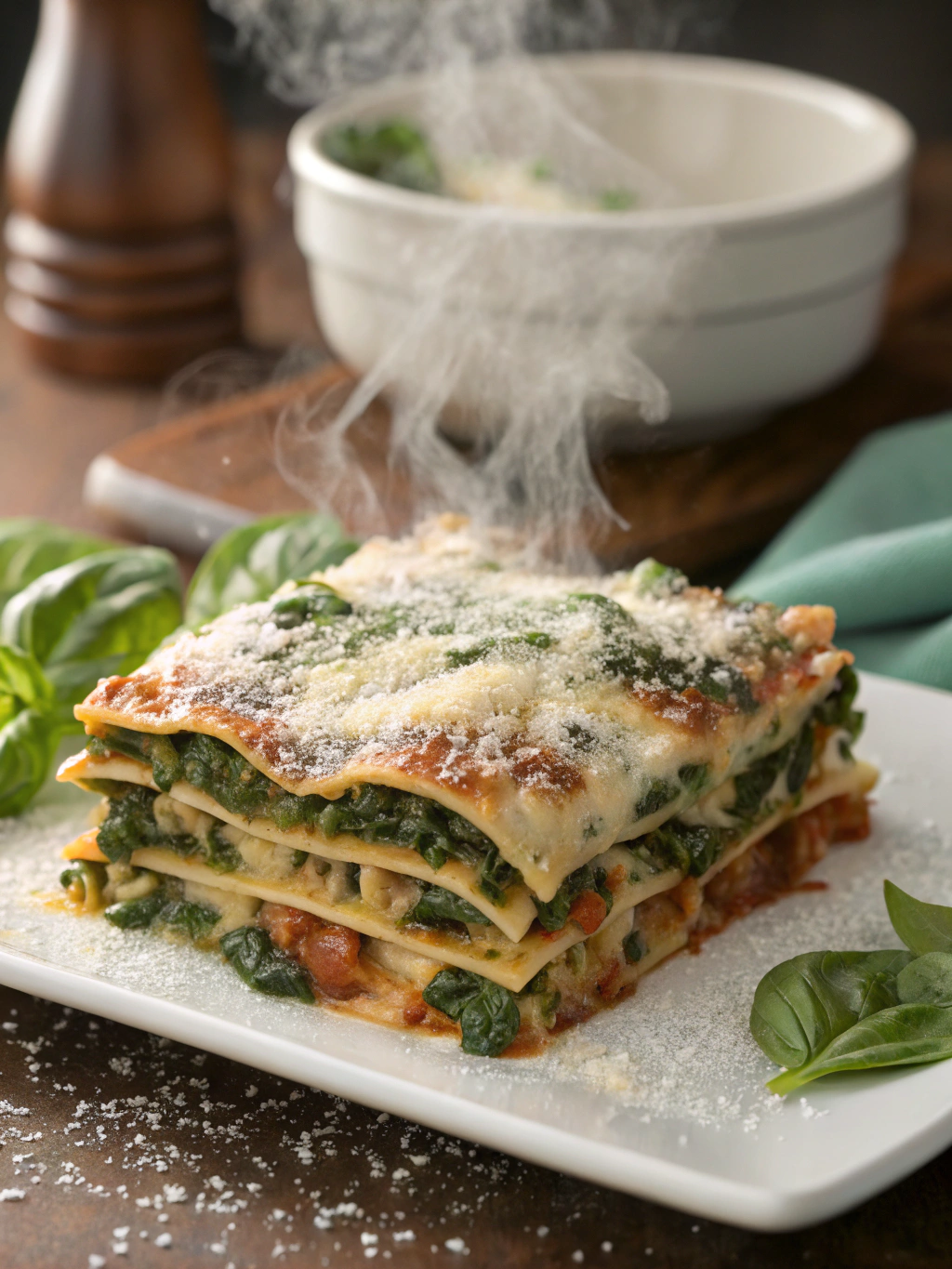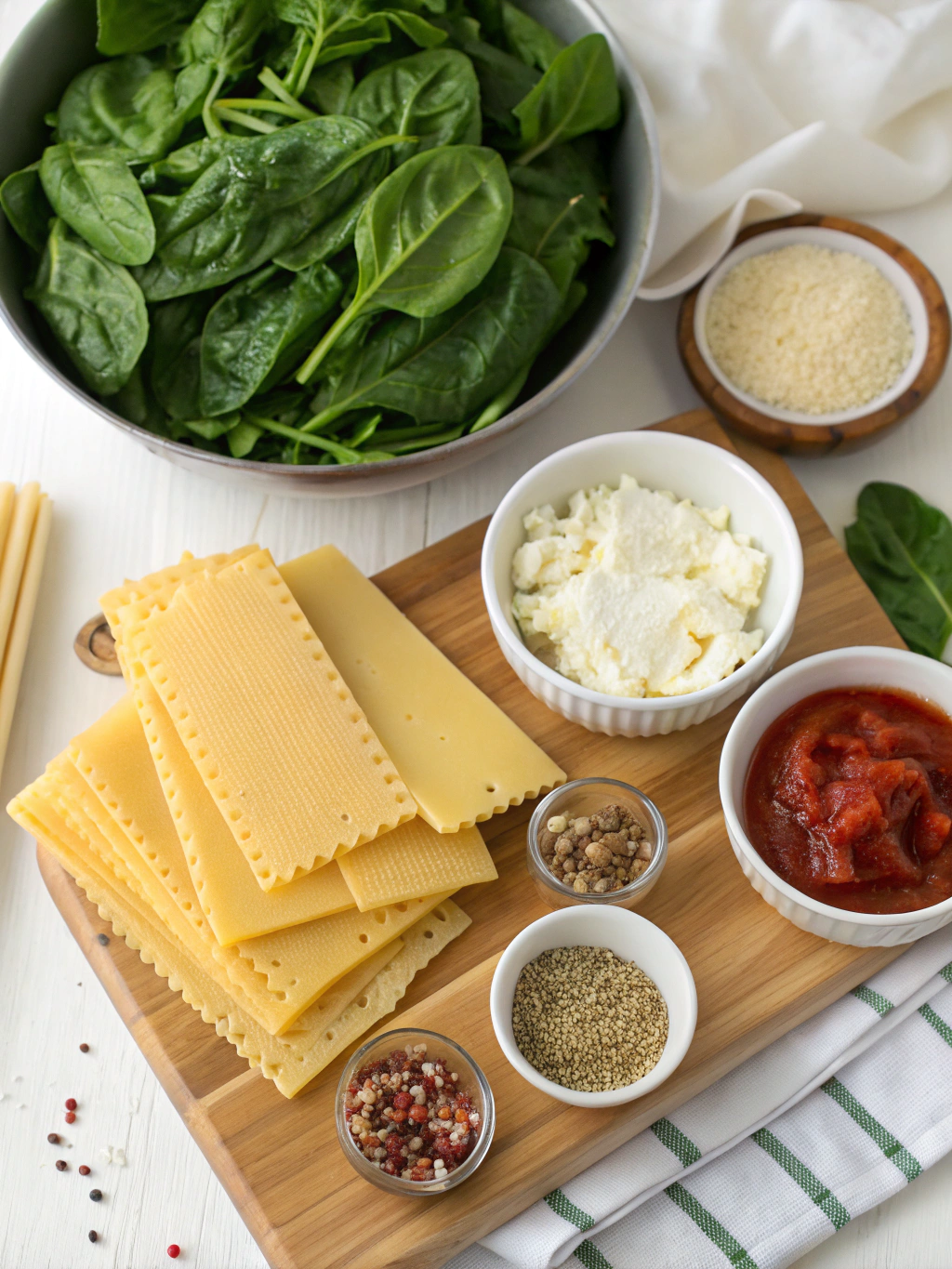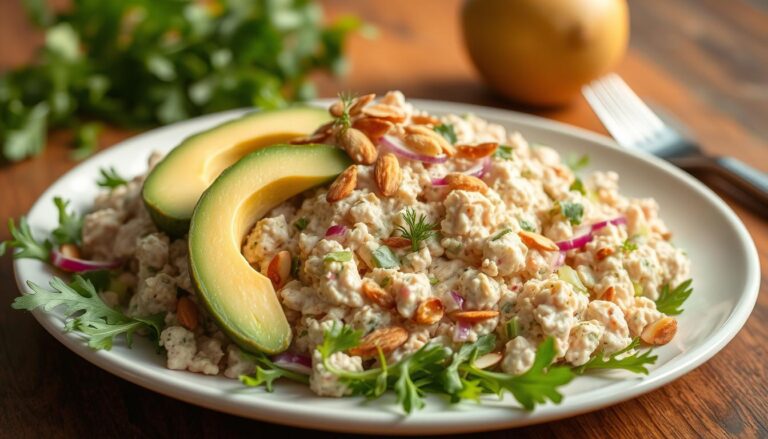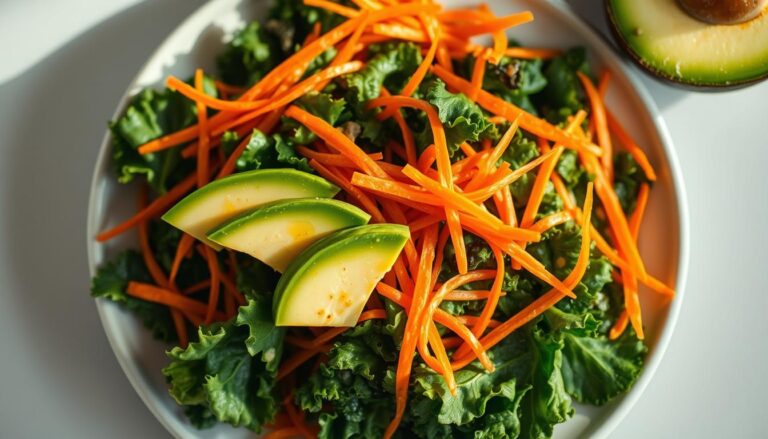Spinach Lasagna
A rich, cheesy spinach lasagna featuring layers of tender pasta, creamy ricotta, vibrant spinach, and zesty marinara sauce. This comforting Italian classic brings restaurant-quality flavor to your family dinner table with simple ingredients and straightforward preparation.
Easy Spinach Lasagna Recipe
There’s something undeniably comforting about a bubbling pan of homemade spinach lasagna fresh from the oven. This timeless Italian dish transforms humble ingredients into something truly magical—layers of tender pasta sheets nestled between vibrant spinach, creamy ricotta, tangy tomato sauce, and gooey melted cheese. What makes this spinach lasagna recipe special is its perfect balance of simplicity and flavor, allowing the freshness of the ingredients to shine through without complicated techniques.
As autumn settles in and evenings grow cooler, this spinach lasagna becomes the perfect weekend project that rewards with multiple delicious meals. While traditional in its roots, this recipe honors Italian heritage with a modern, approachable twist that makes it accessible for home cooks of all skill levels.
THIS RECIPE:
- Features three types of cheese for maximum flavor and creaminess
- Incorporates fresh spinach for nutrients and vibrant color
- Requires no pre-boiling of noodles, saving time and effort
- Creates 8 generous portions perfect for family meals or meal prep
Recipe Details:
| Detail | Information |
|---|---|
| Prep Time | 30 minutes |
| Cook Time | 45 minutes |
| Rest Time | 15 minutes |
| Total Time | 1 hour 30 minutes |
| Servings | 8 portions |
| Yield | One 9×13 inch lasagna |
This spinach lasagna recipe strikes the perfect balance between ease and indulgence. With straightforward preparation and readily available ingredients, you’ll create a restaurant-worthy dish without spending hours in the kitchen. The make-ahead potential makes it ideal for busy weeknights or weekend entertaining, while the tender pasta and rich, cheesy filling deliver classic comfort in every bite.
Ingredients for Spinach Lasagna
The secret to an exceptional spinach lasagna lies in the quality of its ingredients. Each component contributes significantly to the final dish’s flavor profile, texture, and overall appeal. Using fresh, high-quality ingredients ensures your lasagna will have that authentic Italian taste that elevates it from good to unforgettable.
For the Spinach Filling:
- 2 tablespoons olive oil
- 1 medium onion, finely diced
- 3 cloves garlic, minced
- 16 ounces (450g) fresh spinach, roughly chopped
- 15 ounces (425g) ricotta cheese, whole milk preferred
- 1 large egg, lightly beaten
- ½ cup grated Parmesan cheese
- ¼ teaspoon grated nutmeg
- 1 teaspoon salt
- ½ teaspoon freshly ground black pepper
For the Assembly:
- 24 ounces (680g) marinara sauce (homemade or high-quality store-bought)
- 9-12 no-boil lasagna noodles
- 16 ounces (450g) mozzarella cheese, shredded
- ¼ cup grated Parmesan cheese, for topping
The quality of your cheeses will significantly impact your spinach lasagna. Splurge on freshly grated Parmesan rather than the pre-packaged variety, and choose whole-milk ricotta for a creamier texture and richer flavor. For the spinach, fresh is best, but if using frozen, ensure it’s thoroughly thawed and drained to prevent excess moisture in your lasagna.
Ingredient Quality Table:
| Ingredient Category | Recommended Quantity | Quality Tips |
|---|---|---|
| Pasta | 9-12 no-boil sheets | Choose Italian-made for authentic texture |
| Cheese | 3 varieties (ricotta, mozzarella, Parmesan) | Use whole milk varieties for richest flavor |
| Vegetables | 16 oz fresh spinach | Look for bright, crisp leaves without yellowing |
| Sauce | 24 oz marinara | Select sauce with minimal ingredients or make homemade |
| Aromatics | 1 onion, 3 garlic cloves | Choose firm onions and plump, fresh garlic bulbs |
How to Make Spinach Lasagna
Creating the perfect spinach lasagna involves a harmonious layering process that allows each component to shine while melding together into a cohesive dish. The beauty of this recipe is its straightforward process, building layers that will transform in the oven into a bubbling, golden-topped masterpiece.
Prepare the spinach filling: Heat olive oil in a large skillet over medium heat. Add diced onion and cook until translucent, about 3-4 minutes. Add minced garlic and cook for 30 seconds until fragrant. Add fresh spinach in batches, stirring until wilted. Remove from heat and allow to cool slightly.
Make the cheese mixture: In a large bowl, combine ricotta, beaten egg, Parmesan, nutmeg, salt, and pepper. Mix until well incorporated. Once the spinach mixture has cooled, squeeze out any excess moisture and stir into the ricotta mixture until evenly distributed.
Prepare for assembly: Preheat oven to 375°F (190°C). Spread ½ cup of marinara sauce on the bottom of a 9×13-inch baking dish.
Create the first layer: Place 3-4 lasagna noodles over the sauce, slightly overlapping if necessary. Spread ⅓ of the spinach-ricotta mixture over the noodles, followed by ¾ cup marinara sauce and ¼ of the shredded mozzarella.
Continue layering: Repeat the layering process two more times: noodles, spinach-ricotta mixture, sauce, and mozzarella.
Add the final layer: Top with a final layer of noodles, remaining sauce, remaining mozzarella, and ¼ cup Parmesan cheese.
Bake: Cover the dish with aluminum foil, making sure it doesn’t touch the cheese. Bake for 35 minutes. Remove foil and bake for an additional 10-15 minutes until the cheese is bubbly and golden.
Rest before serving: Allow the lasagna to rest for 15 minutes before cutting to help the layers set. This ensures cleaner slices and allows the flavors to meld together.
Pro tip: For the best texture, avoid pressing down on the layers as you assemble. Let them rest naturally to create a lasagna with distinct, beautiful layers.
Tips for Making Spinach Lasagna
Mastering spinach lasagna is all about attention to detail and understanding the small techniques that elevate the final dish. These expert tips will help you avoid common pitfalls and ensure your lasagna turns out perfectly every time.
- Properly drain your spinach: After cooking the spinach, allow it to cool slightly, then squeeze out excess moisture using a clean kitchen towel or cheesecloth. This prevents your lasagna from becoming watery.
- Season each component: Season both the spinach mixture and ricotta mixture adequately. This layered approach to seasoning ensures flavor in every bite.
- Create even layers: Use a spatula to spread each layer evenly, reaching all the way to the corners for consistent texture and flavor throughout.
- Let lasagna rest: The 15-minute rest after baking is crucial, not optional. It allows the layers to set and makes for cleaner slices.
Technique Recommendations:
| Technique | Recommendation | Reason |
|---|---|---|
| Noodle Handling | No need to pre-boil no-boil noodles | They’ll cook perfectly in the sauce’s moisture |
| Cheese Grating | Grate mozzarella yourself | Pre-shredded contains anti-caking agents that affect melting |
| Sauce Distribution | Use slightly more sauce on bottom and top layers | Ensures noodles cook properly and prevents drying out |
| Foil Covering | Spray foil with non-stick spray | Prevents cheese from sticking when removed mid-baking |
When assembling your spinach lasagna, maintain a light touch. Pressing down too firmly compacts the layers and can result in a dense texture. Instead, allow each layer to sit naturally atop the previous one, creating a lasagna with appealing height and distinct layers that showcase your careful preparation.
Make-Ahead Instructions
One of the greatest advantages of spinach lasagna is its make-ahead potential. Preparing this dish in advance not only saves time when you need it most but can actually improve the flavor as the ingredients have more time to meld together.
You can assemble your spinach lasagna completely up to 24 hours before baking. Cover the assembled, unbaked lasagna tightly with plastic wrap and then aluminum foil, and refrigerate. When ready to bake, remove from refrigerator and let stand at room temperature for 30 minutes, then bake as directed, adding an extra 10-15 minutes to the covered baking time.
For longer advance preparation, you can make the spinach-ricotta filling up to 2 days ahead. Store in an airtight container in the refrigerator. You can also prepare the sauce in advance if making homemade—marinara sauce will keep for up to 4 days refrigerated or 3 months frozen.
If you want to freeze your assembled unbaked lasagna, wrap it thoroughly in plastic wrap, then aluminum foil. Label with the date and freeze for up to 3 months. Thaw overnight in the refrigerator before baking, and add approximately 15-20 minutes to the covered baking time.
Pro tip: For the best make-ahead results, slightly undercook your spinach when preparing the filling. It will finish cooking during the baking process, preventing it from becoming too soft in the finished dish.
Storing Leftovers
Proper storage of leftover spinach lasagna ensures you’ll enjoy the same delicious flavors in subsequent meals. When handled correctly, leftover lasagna can be nearly as good as freshly made—sometimes even better as the flavors continue to develop.
Allow lasagna to cool completely before refrigerating, but don’t leave it at room temperature for more than 2 hours for food safety. For best results, portion leftover lasagna into individual servings before storing. This makes reheating more efficient and prevents repeatedly heating the entire dish.
Store leftovers in airtight containers or wrap individual portions tightly in aluminum foil. Properly stored, leftover spinach lasagna will maintain quality in the refrigerator for 3-4 days. For optimal freshness, store the lasagna away from strong-smelling foods as it can absorb odors.
To reheat individual portions, place in a microwave-safe dish, cover loosely with a damp paper towel, and heat on medium power for 2-3 minutes, or until the internal temperature reaches 165°F. For a crisper top, finish under the broiler for 1-2 minutes. Alternatively, reheat in a 350°F oven, covered with foil, for about 20 minutes or until heated through.
Freezing Spinach Lasagna
Spinach lasagna freezes beautifully, making it an excellent option for meal prepping or preserving leftovers for future enjoyment. The key to successfully freezing lasagna lies in proper wrapping and storage techniques.
For the best quality when freezing baked lasagna, allow it to cool completely, then cut into individual portions. Wrap each portion in a layer of plastic wrap, followed by a layer of aluminum foil. This double-wrapping method prevents freezer burn and preserves flavor. Label each package with the date and contents.
If freezing an entire lasagna, use a freezer-to-oven safe container so you can bake it directly from frozen if desired. Wrap the entire container in plastic wrap, then aluminum foil, creating a tight seal to prevent air exposure.
Frozen spinach lasagna maintains best quality for up to 3 months. Beyond this timeframe, it remains safe to eat but may experience some texture and flavor changes.
When ready to enjoy, thaw frozen lasagna in the refrigerator overnight for the best texture results. Reheat thawed lasagna in a 350°F oven until it reaches an internal temperature of 165°F, typically 30-45 minutes for a full lasagna or 15-20 minutes for individual portions. If baking from frozen, remove the plastic wrap but keep the foil in place, and bake at 375°F for about 1 hour, then uncover and bake an additional 15 minutes until hot and bubbly.
Pro tip: For the freshest taste after freezing, add a small amount of fresh marinara sauce on top before reheating to restore moisture and brightness.
Serving Suggestions
A beautiful spinach lasagna deserves thoughtful accompaniments that complement its rich flavors and create a balanced meal. The ideal sides add contrasting textures and flavors without competing with the star of the show.
A simple, crisp green salad with a light vinaigrette provides the perfect counterpoint to the rich, creamy lasagna. Try arugula with lemon dressing, or a classic Caesar salad with homemade croutons. For a heartier option, serve garlic bread or warm Italian bread with olive oil for dipping. The bread is perfect for soaking up any extra sauce on the plate.
When presenting your spinach lasagna, consider serving it on warmed plates to keep it at the optimal temperature longer. A sprinkle of fresh basil or parsley adds a pop of color and fresh flavor just before serving. For special occasions, a small drizzle of high-quality extra virgin olive oil adds a luxurious touch.
Beverage Pairings:
- A medium-bodied Italian red wine like Chianti or Sangiovese complements the tomato and cheese flavors
- For white wine lovers, a crisp Pinot Grigio balances the richness
- Sparkling water with lemon provides a refreshing non-alcoholic option
- For family meals, Italian sodas in various flavors offer a fun, festive touch
Serve your spinach lasagna at the ideal temperature—hot but not scalding, allowing the cheese to be melted and stretchy but not liquid. The perfect slice should hold its shape while still being tender enough to cut with the side of a fork.
FAQ
Can I use frozen spinach instead of fresh?
Yes, you can substitute frozen spinach for fresh. Use two 10-ounce packages of frozen chopped spinach, thawed completely and squeezed dry. Since frozen spinach is already blanched, you can skip the cooking step and add it directly to the ricotta mixture after thoroughly draining. This substitution saves time while maintaining the nutritional benefits.
What can I substitute for ricotta cheese?
If you don’t have or don’t prefer ricotta, cottage cheese makes an excellent substitute. For the best texture, blend it briefly in a food processor for a smoother consistency similar to ricotta. Alternatively, a combination of cream cheese and sour cream (equal parts) can work in a pinch, though this creates a richer, tangier profile than traditional ricotta.
Do I really need to let the lasagna rest before serving?
Yes, the resting period is crucial. During the 15-minute rest, the lasagna’s structure sets, allowing the layers to bond and excess moisture to be reabsorbed. Without this rest, the lasagna will likely fall apart when served and may appear watery on the plate. Think of it as similar to resting meat after cooking—it’s a small time investment that dramatically improves the final result.
My lasagna seems watery. What went wrong?
Excess moisture typically comes from three sources: inadequately drained spinach, overly wet ricotta, or too much sauce. To fix this in the future, squeeze spinach thoroughly after cooking, drain ricotta in a fine-mesh strainer for 30 minutes before using, and use a slightly thicker marinara sauce. If you’re using no-boil noodles, they need moisture to cook properly, but too much creates a soggy lasagna. Finding the right balance comes with practice.
Can I make this spinach lasagna vegan?
Absolutely! Replace the ricotta with a tofu-based substitute (blend firm tofu with nutritional yeast, lemon juice, and herbs), use plant-based mozzarella and Parmesan alternatives, and replace the egg with 1 tablespoon of cornstarch mixed with 2 tablespoons of water as a binding agent. Ensure your pasta is egg-free, and you’ll have a delicious vegan version that maintains the spirit of traditional spinach lasagna while accommodating plant-based diets.








